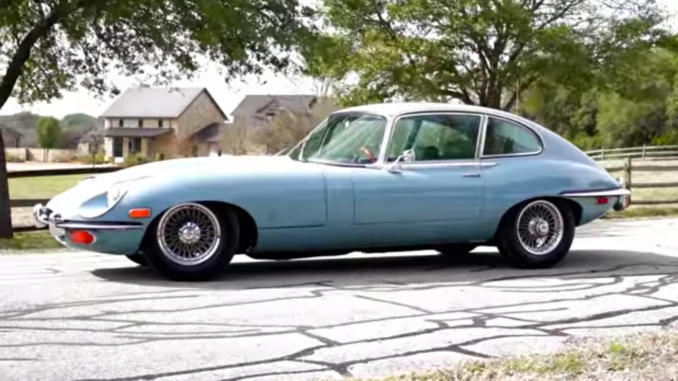
Jaguar, the company, began as the Swallow Sidecar Company in 1922, manufacturer of sidecars for motorcycles. In 1933 the company became S. S. Cars Limited, which made automobiles, some models of which were named Jaguar. In 1945, the company was renamed Jaguar Cars Ltd, and really hit its stride in the post-war era. Their main product was luxury sedans (saloons), but became famous for building a series of very successful sports cars that became racing history legends.
The Jaguar XK120, produced 1948-1954, won races in England and America, and performed well enough in France’s 1950 Le Mans 24 Hours race that company executives committed to competing in the famous endurance race for years to come. That decision earned them a rich payoff, winning Le Mans in 1951, 1953, 1955, 1956 and 1957.
The Jaguar XK140, produced 1955-1957, improved on its predecessor in many ways, but most importantly it won races. Racing fame translated directly into car sales. There wasn’t a better or more effective sales and marketing strategy than proving, repeatedly, that Jaguar built the cars that consistently won the toughest races in the world. Next came the XK150, produced 1957-1961, and while it continued to build on Jaguar’s winning reputation, the company was developing a new prototype, a direct descendant and beneficiary of Jaguar’s racing heritage.
The first prototype of the new car, E1A, was constructed in 1957. Utilizing a monocoque design, meaning that the engine, front suspension, front fenders and hood (or bonnet) were bolted to a subframe which in turn was bolted to the body. There was no traditional frame under this car, saving alot of weight, making the car lighter and thus faster. The second prototype, E2A, was purpose-built to race and competed at Le Mans and in America in 1960.
The pinnacle of Jaguar’s sports car lineage was now ready for the public. Unveiled on March 15, 1961 at the Geneva Auto Salon, the Jaguar E-Type moved the great Italian auto designer Enzo Ferrari to declare it, “the most beautiful car ever made”. But it wasn’t just a pretty face. The E-Type (marketed as the XK-E in North America) was fast, able to go 0-60 mph in under 7 seconds and reach a top speed of 150 mph. (Actually, production cars had a top speed of about 140 mph – the car had to be specially prepared to reach 150 mph). If this had been an American-built car, it would have become known as a muscle car due to its light weight to high horsepower ratio. Additionally, the new sports car had fully independent suspension (both front and rear), rack-and-pinion steering, and disc brakes on all four wheels. It was less expensive than its competition, but as fast or faster than the leading sports cars of the day. To the public, it was an absolute sensation. Due to parts supply difficulties, Jaguar wasn’t able to build enough of the cars to meet demand in the first year of production.
Initially, the E-Type (or XK-E if you prefer) was available as either a two seat roadster (convertible) or a two seat coupé. Consumer demand for more cabin space led to an additional model, the 2+2 coupé, in 1966. To accomodate a backseat, the wheelbase as well as the overall length of the car were stretched slightly more than 9 inches longer than the 2 seat coupé and roadster models. The design evolved over time, primarily to comply with American safety and emissions regulations. However, one improvement that became a legend of its own was the eventual replacement of the inline 6 cylinder with the now-famous Jaguar V12 engine.
If you’re a fan of Jaguars, I recommend “The Jaguar XK-E Story” (15:06):
Question of the Night: Which classic European car would you want in your garage?
